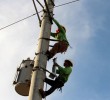According to Casiño, the Imem is similar to the existing wholesale electricity spot market in Luzon and is said to be also very dangerous “because it may easily be manipulated by power players.”
By MARILOU AGUIRRE-TUBURAN
Davao Today
DAVAO CITY, Philippines — Bayan Muna Representative Teddy Casiño expressed apprehension on the proposed Interim Electricity Market in Mindanao (Imem), which aims to bring into the Mindanao power grid some 360MW of embedded supply but which would require a 30 centavo (USD 0.01) hike in prices.
According to Juland Suazo of environmental rights group Panalipdan, Imem is a “modified” Wesm (Wholesale Electricity Spot Market), a power trading center which promised to put ‘free market’ in place. With this, electricity rates are said to “go down” based on the “false” assumption that “retail competition will drive prices down.”
In Luzon and Visayas, Wesm resulted to the rising costs of electricity due to more expensive power sources.
According to Casiño, the Imem is similar to the existing wholesale electricity spot market in Luzon and is said to be also very dangerous “because it may easily be manipulated by power players.”
As Imem faces stiff opposition, militants reiterate its call to stop privatization of Mindanao power plants.
Casiño said the Agus-Pulangui hydropower complex should also be “permanently exempted from privatization.”
“Putting the Agus-Pulangui under public control would help Filipinos from the impact of financial crisis,” maintains Suazo.
The Electric Power Industry Reform Act (Epira) provisions on privatization should also be amended, Casiño added.
The Epira was one of the major laws enacted by former President Gloria Macapagal-Arroyo. It paved the way for the full privatization of the country’s power industry as it allowed the sale of power plants to private bidders.
The law prohibits the national government from building new power plants, thus, it relies on private investors for the construction of new plants to meet the country’s growing energy needs.
It also provides that the projected capacity is to be constructed by Independent Power Producers (IPPs). Private investors and IPPs will only build and maintain power plant if it remains economically viable and earn profits for them.
Epira, according to Bagong Alyansang Makabayan in Southern Mindanao, also paved the way for selling various power assets of the government to private corporations at largely undercut prices from their appraised values.
The Transco (now the National Grid and Power Corporation or NGCP) was sold to Henry Sy at only USD 3.95 billion. But Bayan said, Sy only paid an installment of USD 987.5 million while the remaining balance of USD 2.962 billion or PHP 148 billion will be paid within 15 years.
It added that the average annual income of NGCP is PHP 15 billion, thus, the accumulated income within 15 years would be PHP 225 billion. “Sy will rake in a profit of 77 billion pesos from privatized State assets with a minimal investment,” Bayan said.
Eleven years after it took effect, the Epira has made the Philippines number three among Asian countries that have the most expensive power rates. Based on the 2006 Comparative Power Rates in Asia, the power rates here for residential amounts to USD 17.4 cents and USD 16.7 cents industrial. (Marilou Aguirre-Tuburan/davaotoday.com)










